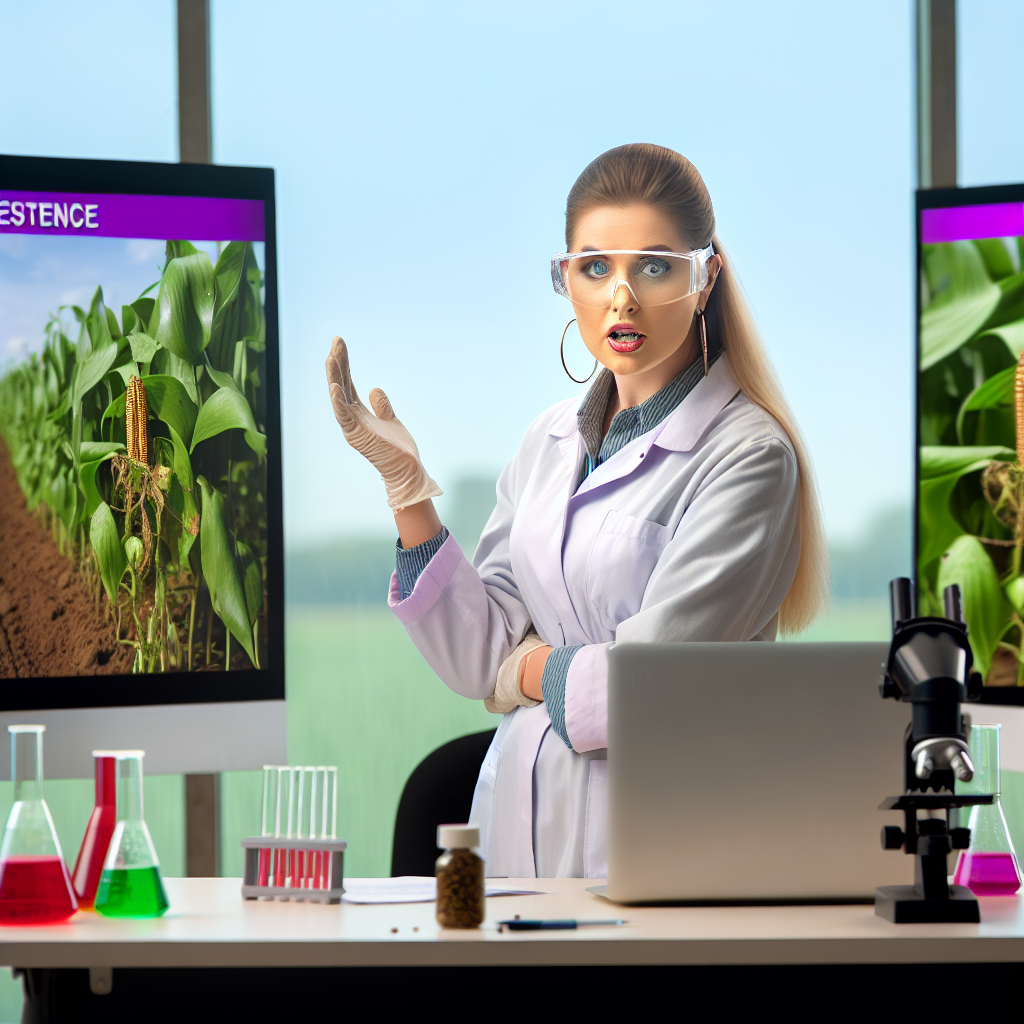Introduction to Pest Resistance in Agriculture
Pest resistance plays a crucial role in modern agriculture.
Farmers face numerous challenges from pests that threaten crop yields.
To combat these challenges, they increasingly rely on genetically modified crops.
These crops are specifically engineered to withstand pest attacks.
Consequently, pest-resistant crops can lead to higher productivity.
Moreover, they reduce the need for chemical pesticides.
This approach benefits both farmers and the environment.
Understanding the science behind pest resistance is essential.
Researchers utilize various methods to enhance resistance in crops.
Ultimately, this area of study is vital for sustainable agriculture.
The Science Behind Pest Resistance
At the core, pest resistance involves genetic modifications.
Scientists insert specific genes from bacteria or plants into crops.
These genes enable plants to produce natural insecticides.
As a result, pests find it difficult to thrive on these crops.
Genetically modified organisms (GMOs) also include traits for endurance.
Transform Your Agribusiness
Unlock your farm's potential with expert advice tailored to your needs. Get actionable steps that drive real results.
Get StartedThis includes resistance to drought and disease.
These advancements allow for diverse agricultural practices.
Benefits of Pest-Resistant Crops
Pest-resistant crops provide multiple advantages in agriculture.
- They increase crop yield and profitability for farmers.
- They decrease reliance on chemical pesticides.
- They help preserve beneficial insect populations.
- They support sustainable farming practices.
These benefits contribute to overall food security.
Moreover, they promote environmental health.
Challenges and Considerations
Despite their advantages, challenges exist with pest-resistant crops.
Some pests may develop resistance to the genetic modifications.
This emergence could lead to increased pest populations.
Ongoing research is crucial to address these issues.
Additionally, public perception plays a significant role.
Consumers often express concerns about GMOs.
Effective communication is essential to inform the community.
Involving stakeholders can help navigate these challenges.
The Role of Genetically Modified Crops in Pest Management
Introduction to Pest Resistance
Genetically modified (GM) crops significantly impact pest management strategies.
These crops incorporate specific traits that enhance resistance to pests.
Farmers benefit from reduced losses due to insect infestations.
Mechanism of Pest Resistance
GM crops often contain genes from bacteria or other organisms.
These genes produce proteins that are toxic to specific pests.
Crops like Bt corn exemplify this technology with their built-in insect resistance.
As a result, they require fewer pesticide applications.
Biodiversity and Ecosystem Impact
Using GM crops can lead to enhanced biodiversity in agricultural ecosystems.
They can reduce reliance on broad-spectrum pesticides.
This shift protects beneficial insects and promotes ecological balance.
Economic Benefits for Farmers
Farmers experience economic advantages with GM crops due to pest resistance.
Showcase Your Farming Business
Publish your professional farming services profile on our blog for a one-time fee of $200 and reach a dedicated audience of farmers and agribusiness owners.
Publish Your ProfileReduced pesticide costs translate to higher profits.
Moreover, increased yields are achieved because of less crop damage.
Future Considerations in Pest Management
As pest resistance in GM crops grows, continuous monitoring is crucial.
Resistance management strategies must evolve to prevent pest adaptation.
Furthermore, ongoing research will enhance GM technology for better pest control.
Community and Regulatory Perspectives
Community acceptance of GM crops varies widely across regions.
Regulatory frameworks govern their use and ensure safety for consumers.
Transparent communication helps allay public concerns regarding GM technology.
Mechanisms of Pest Resistance in Genetically Modified Crops
Introduction to Genetic Modification
Genetically modified crops undergo specific alterations to enhance their traits.
This process often focuses on improving pest resistance.
Biological Mechanisms
Biological mechanisms play a crucial role in pest resistance.
One common method includes the introduction of specific genes.
These genes produce proteins that deter pests.
For example, the Bt toxin from Bacillus thuringiensis is widely used.
When ingested by pests, this toxin disrupts their digestive systems.
Chemical Mechanisms
Chemical mechanisms also contribute significantly to pest resistance.
Some genetically modified plants synthesize secondary metabolites.
These compounds can repel or poison harmful insects.
For instance, alkaloids are known for their toxic properties.
Resistance Mechanisms
Resistance mechanisms vary among different modified crops.
Some crops employ a multi-gene approach for added pest resistance.
This strategy complicates pests’ ability to adapt quickly.
Instead, pests typically require more time to develop resistance.
Significance of Genetic Diversity
Genetic diversity enhances the effectiveness of pest resistance.
By incorporating various traits, crops can better withstand pest attacks.
This diversity reduces the likelihood of pest outbreaks.
Consequently, it promotes more sustainable agricultural practices.
Field-Level Implications
At the field level, pest-resistant genetically modified crops demonstrate benefits.
Farmers experience reduced pesticide usage with these crops.
Lower pesticide usage results in decreased environmental impact.
Moreover, it leads to higher crop yields and economic benefits.
Challenges of Pest Resistance
There are challenges associated with pest resistance in modified crops.
One concern is the potential for pest resistance development.
Over time, some pests may evolve and adapt to the modifications.
Thus, continuous monitoring and research are essential.
Future Directions
Future advancements in genetic modification hold promise for pest resistance.
Innovations in genome editing techniques could enhance traits further.
This evolution might lead to even more effective pest control methods.
Ultimately, the goal remains sustainable agriculture for future generations.
Gain More Insights: How IoT Enhances Precision Farming Techniques
Showcase Your Farming Business
Publish your professional farming services profile on our blog for a one-time fee of $200 and reach a dedicated audience of farmers and agribusiness owners.
Publish Your ProfileBenefits of Using Genetically Modified Crops for Pest Resistance
Enhanced Crop Yield
Genetically modified crops exhibit stronger resistance to pests.
This resistance directly contributes to higher crop yields.
Farmers enjoy increased profits from less damaged produce.
Moreover, enhanced yields help stabilize food supply.
Reduction in Chemical Use
Modified crops often require fewer chemical pesticides.
This reduction benefits both the environment and human health.
Less chemical use leads to lower production costs for farmers.
Consequently, consumers also enjoy safer food options.
Lower Pest Populations
Genetically modified crops can disrupt pest life cycles.
This disruption helps decrease overall pest populations.
With fewer pests, crops sustain less damage over time.
As a result, this promotes more sustainable farming practices.
Increased Food Security
Higher crop yields enhance food availability.
This is particularly crucial in regions facing food shortages.
Genetically modified crops hold potential for global food security.
Thus, they can assist in combating hunger worldwide.
Environmental Benefits
Reduced chemical application helps protect local ecosystems.
Additionally, pest-resistant crops can reduce soil degradation.
Healthier soils support better agricultural practices over time.
Ultimately, this offers a more sustainable approach to farming.
Learn More: Connecting Farmers To Global Markets With Blockchain Technology
Challenges and Concerns Associated with Pest Resistance in GM Crops
Impact on Non-Target Species
Pest-resistant GM crops can unintentionally harm non-target species.
This change disrupts local ecosystems and biological controls.
For example, beneficial insects like ladybugs might decline in number.
As a result, farmers may face increased pest problems over time.
Resistance Development in Pests
Over time, pests can develop resistance to GM crops designed to kill them.
This evolution can lead to new pest populations that are hard to control.
Farmers may need to apply stronger pesticides, impacting their practices.
Consequently, this issue raises concerns about sustainability in agriculture.
Economic Impacts on Farmers
The initial costs of adopting GM crops can be high for farmers.
Farmers must invest in seeds and possible additional pesticides.
If pest resistance increases, they may face further financial burdens.
This economic pressure can lead to debt and financial instability.
Regulatory Challenges
Regulations surrounding GM crops can vary significantly by region.
Inconsistencies can create confusion for farmers and consumers alike.
Moreover, navigating these regulations can be time-consuming and costly.
In turn, this discourages the adoption of beneficial technologies.
Public Perception and Market Demand
Public perception of GM crops often leans toward skepticism.
This skepticism can drive demand for organic and non-GMO products.
Consequently, farmers may struggle to sell their GM crops.
Showcase Your Farming Business
Publish your professional farming services profile on our blog for a one-time fee of $200 and reach a dedicated audience of farmers and agribusiness owners.
Publish Your ProfileThis market pressure can affect their livelihood.
Environmental Concerns
There are concerns about the long-term environmental effects of GM crops.
For example, monoculture practices can deplete soil health.
The reduction in crop diversity can impact resilience to climate change.
Additionally, loss of biodiversity is a critical concern for ecologists.
Learn More: AI Technologies Transforming Agriculture

Case Studies: Successful Examples of Pest-Resistant GM Crops
Bt Cotton
Bt cotton is a well-known genetically modified crop.
This crop contains a gene from the bacterium Bacillus thuringiensis.
This gene produces a protein toxic to specific pests, such as the cotton bollworm.
Farmers have noted significant reductions in pest damage since its introduction.
Moreover, Bt cotton has led to decreased pesticide use, promoting environmental health.
Countries like India have reported higher yields and increased income for farmers using Bt cotton.
Bt Corn
Another example is Bt corn, which contains similar genetic modifications.
This crop effectively controls European corn borer and other pests.
Farmers benefit from reduced reliance on chemical insecticides.
Data shows increased profitability for those who adopt Bt corn.
Moreover, this crop has contributed to sustainable farming practices.
Golden Rice
Golden Rice represents another success story in GM crops.
This rice has been enhanced with vitamin A to combat malnutrition.
While primarily a nutritional crop, it also has pest-resistant traits.
Studies reveal its potential to reduce pesticide use in rice farming.
Furthermore, it aims to improve health outcomes in vulnerable populations.
Roundup Ready Soybeans
Roundup Ready soybeans show how GM crops can simplify weed management.
These soybeans are resistant to glyphosate, a common herbicide.
This trait allows farmers to manage weeds effectively and economically.
As a result, farmers have observed increased yields and reduced labor costs.
Moreover, this approach supports integrated pest management strategies.
Sustainable Impact
Overall, these case studies illustrate the benefits of pest-resistant GM crops.
They showcase improved crop yields and reduced chemical usage.
Farmers experience economic advantages while promoting environmental sustainability.
As biotechnology advances, further developments in pest resistance are expected.
These innovations may reshape agricultural practices worldwide.
Delve into the Subject: Maximizing Farm Profitability With Innovative Agri-Fintech Solutions
Regulatory Frameworks Governing the Use of GM Crops with Pest Resistance
Introduction to Regulatory Frameworks
Regulatory frameworks ensure the safe use of genetically modified (GM) crops.
They govern the approval and commercialization of these crops.
Different countries have varying regulations in place.
These vary significantly between regions and even from state to state.
Key Regulatory Bodies
Several organizations oversee the regulation of GM crops.
The U.S. Environmental Protection Agency (EPA) plays a significant role.
The Food and Drug Administration (FDA) also evaluates GM food safety.
Showcase Your Farming Business
Publish your professional farming services profile on our blog for a one-time fee of $200 and reach a dedicated audience of farmers and agribusiness owners.
Publish Your ProfileIn addition, the U.S. Department of Agriculture (USDA) regulates the cultivation of these crops.
In Europe, the European Food Safety Authority (EFSA) evaluates GM products.
Approval Process for GM Crops
The approval process for GM crops can be lengthy and complex.
First, developers must conduct extensive research and testing.
This research verifies both effectiveness and safety for humans and the environment.
Afterward, they submit data to relevant regulatory bodies for evaluation.
These organizations thoroughly review the data before granting approval.
Public and Environmental Safety Assessments
Assessments focus on potential impacts on human health and the environment.
These evaluations consider aspects such as toxicity and allergenicity.
Moreover, potential effects on non-target species are also assessed.
Environmental studies examine biodiversity and ecosystem health.
Global Variations in Regulations
Regulatory approaches differ worldwide regarding GM crops.
In the United States, regulations tend to be less stringent compared to Europe.
Some countries, like India, have specific regulations tailored to local needs.
Conversely, some countries strictly limit or prohibit GM crop cultivation.
Labeling and Consumer Transparency
Labeling of GM foods remains a contentious issue.
Some countries require clear labeling of genetically engineered products.
This allows consumers to make informed choices.
Other regions, however, have less stringent labeling requirements.
Future Directions in Regulation
As technology evolves, so do regulatory frameworks.
Experts are advocating for more adaptive regulations.
These regulations could better address emerging biotechnologies.
Continuous stakeholder engagement will shape future regulations.
Ultimately, public perception will influence the trajectory of GM crop regulations.
Future Perspectives on Pest Resistance in Genetically Modified Crops
Advancements in Genetic Engineering
Researchers continually explore new genetic modifications for pest resistance.
These advancements allow crops to better withstand pest pressures.
Moreover, they enhance the efficiency of existing resistance traits.
Innovations in CRISPR technology could simplify the modification process.
This method offers precision in targeting specific pest resistance genes.
As a result, more resilient crops could emerge from research labs.
Integration of Pest Management Strategies
Farmers are increasingly combining GM crops with integrated pest management strategies.
This combination amplifies pest control while reducing chemical reliance.
Practices such as crop rotation enhance the effectiveness of GM crops.
Additionally, employing beneficial insects can bolster pest resistance naturally.
These strategies encourage sustainable agricultural practices overall.
Regulatory Frameworks and Public Perception
Regulatory bodies continuously adapt to new GM crop technologies.
Striking a balance between innovation and safety remains crucial.
Public perception also plays a pivotal role in the acceptance of GM crops.
Educating consumers about the benefits of pest-resistant crops is essential.
Transparency from agricultural companies can foster trust in GM technologies.
Showcase Your Farming Business
Publish your professional farming services profile on our blog for a one-time fee of $200 and reach a dedicated audience of farmers and agribusiness owners.
Publish Your ProfileLong-Term Sustainability Goals
Pest resistance in GM crops aligns with long-term sustainability goals.
These crops can reduce the need for chemical insecticides significantly.
Consequently, they contribute to healthier ecosystems.
Additionally, they can improve food security in the face of climate challenges.
This dual benefit emphasizes the importance of ongoing research and investment.




